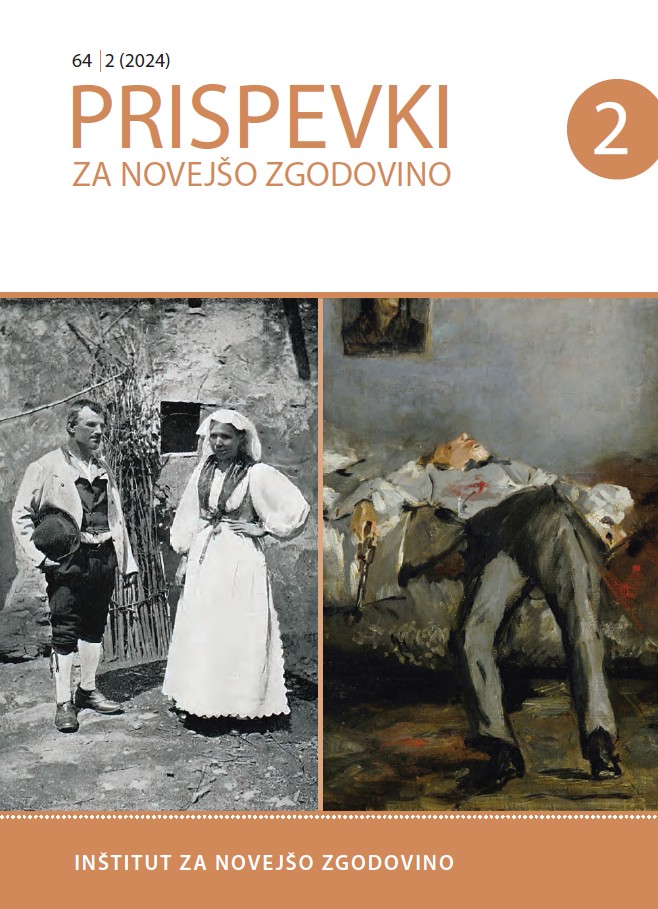Microfinance Providers and Rural Lending in the Province of Carniola Before 1914: a Case Study of the District Credit Cooperative Litija
DOI:
https://doi.org/10.51663/pnz.64.2.01Keywords:
microfinance, rural lending, savings banks, credit cooperatives, District Credit Cooperative LitijaAbstract
The study provides new insights and compares two different types of microfinance intermediaries and their role and impact on the economic and financial situation of the rural population before the beginning of World War I. The abolition of serfdom in the Habsburg monarchy in 1848 had a significant impact on traditional life in the second half of the 19th century. Peasants became landowners, and their participation in the market and monetary economy became crucial. The development of microfinance intermediaries, such as savings banks and credit cooperatives, was essential for the financial inclusion of the rural population. The article shows the development of credit operations in a rural environment using the example of the District Credit Cooperative Litija.
References
Archival material
SI AS – Arhiv Republike Slovenije:
SI AS 444 Okrajna posojilnica Litija
SI_ZAL_LJU – Zgodovinski arhiv Ljubljana
SI_ZAL_LJU/0362 Zbirka muzeja denarnih zavodov Slovenije, Ljubljana (1873–1966)
SI_ZAL_LJU/0085 Okrožno sodišče Ljubljana (1852–1982)
Periodicals
“Naznanilo hranilnice in zastavnice.” Slovenski narod, 8 May 1881. Accessed: 15 August 2023.
“Nova posojilnica v Litiji,” Domovina, 25 August 1894. Accessed: 20 August 2023, https://www.dlib.si/details/URN:NBN:SI:DOC-4JRWENGN.
“Občni zbor kranjske hranilnice.” Slovenec, 30 July 1888. Accessed: 15 August 2023.
Published sources
Statistik der Sparkassen in Österreich für das Jahr 1913 bearbeitet vom Bureau der K. K. Statistischen Zentralkomission, Neue Folge Österrichische Statistik Herausgegeben von der K. K. Statististischen Zentralkommission, 15. Band, 1. Heft. Wien: Der kaiserlich-königlichen Hof- und Staatsdruckerei 1916. Accessed: 29 February 2024, https://alex.onb.ac.at/cgi-content/alex?aid=ost&datum=0015&pos=3&size=45
Bleiweis, Janez. Zgodovinske črtice važnejšega delovanja c. k. kmetijske družbe na Kranjskem od pričetka njenega v letu 1767 do konca leta 1867, Ljubljana: C. k. kmetijska družba na Kranjskem, 1867.
Lapajne, Ivan. Slovenski posojilničar. Drugi, poporavljeni in pomnoženi natis »Navoda o snovanju in poslovanju slovenskih posojilnic, Krško: Založil pisatelj, 1907.
Mohorič, Ivan. “Razvoj kreditnega zadružništva.” Veda. Dvomesečnik za znanost in kulturo 3, no. 1 (1913): 34–58.
Štibler, Miloš. “Trideset let zadružnega dela,” Zadruga 8/9/10 (1913): 199–239. Accessed: 15 December 2023, https://www.dlib.si/details/URN:NBN:SI:DOC-TVON62FD
Literature
Colvin, Cristopher L. Stuart Henderson and John D. Turner. “The Origins of the (Cooperative) Species: Raiffeisen Banking in the Netherlands, 1898–1909,” European Review of Economic History 4 (2020): 749–782. Accessed: 15 August 2023, DOI: https://doi.org/10.1093/ereh/hez018
Eli, Damjan. Litijsko šolstvo skozi čas. Litija: Osnovna šola, Litija: Osnovna šola, 2000.
Fischer, Jasna and Franc Rozman. “Socialna demokracija in kmetijstvo na Slovenskem 1870-1918”, Prispevki za novejšo zgodovino XXVII, 1 (1997): 5–16.
Glasserman, Paul and Peyton H Young. “Contagion in Financial Networks,” Journal of Economic Literature 3 (2016): 779–781. DOI: 10.1257/jel.20151228
Guinnane, Timothy. “Cooperatives as Information Machines: German Rural Credit Cooperatives, 1883–1914.” The Journal of Economic History, 2 (2002): 368.
Helms, Brigit. Access for all. Building Inclusive Financial Systems, Washington: The International Bank for Reconstruction and Development / The World Bank, 2006.
Henig Miščič, Nataša. “Odnos Kranjske hranilnice do malega kmeta v sedemdesetih in osemdesetih letih 19. stoletja” in: Lakote in pomanjkanje: slovenski primer, ed. Mojca Šorn, 99–112. Ljubljana: Inštitut za novejšo zgodovino, 2018.
Kresal, France. Zgodovina socialne in gospodarske politike v Sloveniji od liberalizma do druge svetovne vojne, edd. Neven Borak, Žarko Lazarević, Ljubljana: Cankarjeva založba, 1998.
Lazarević, Žarko. Delo in zemlja: male študije kmečkega sveta, Ljubljana: Inštitut za novejšo zgodovino, 2022.
Lazarević, Žarko. Kmečki dolgovi na Slovenskem. Socialno-ekonomski vidiki zadoženosti slovenskih kmetov 1848 – 1948, Ljubljana: Znanstveno in publicistično središče, 1994.
Lazarevič, Žarko. Plasti prostora in časa: iz gospodarske zgodovine Slovenije prve polovice 20. stoletja, Ljubljana: Inštitut za novejšo zgodovino, 2009.
Lazarević, Žarko and Jože Prinčič. Zgodovina slovenskega bančništva, Ljubljana: ZBS - Združenje bank Slovenije, 2000.
Lazarević, Žarko, Marta Rendla, and Janja Sedlaček, Zgodovina zadružništva v Sloveniji (1856–1992), Ljubljana: Zadružna zveza, 2023.
Ledgerwood, Joanna. Microfinance handbook. An Institutional and Financial Perspective. Washington, D. C.: The World Bank 1998.
Pammer, Tuncer. “Economic policy during the long 19th century,” in: The Economic History of Central, East and South-East Europe, ed. Matthias Morys, 2–14. Abingdon (Oxon); New York: Routledge, 2021.
Pančur, Andrej. V pričakovanju stabilnega denarnega sistema, Celje: Zgodovinsko društvo, 2003.
Perovšek, Jurij. “Schulze-Delitzscheva zadružnogospodarska doktrina kot liberalni odgovor na socialno vprašanje v 19. stoletju,” Prispevki za novejšo zgodovino 37, 1 (1997): 17–34.
Seručnik, Miha. “Prebivalstvo, kmetijstvo in vinogradništvo okrajnega glavarstva Litija na začetku 20. stoletja,” in: Iz zgodovine Litije in okolice, ed. Miha Preinfalk, 567–578. Ljubljana: Zveza zgodovinskih društev Slovenije, 2011.
Seručnik, Miha. “Socialne razmere na kranjskem podeželju v luči gradiva za kmetijsko anketo 17. in 18. Aprila 1884 v Ljubljani,” in: Kronika. Časopis za slovensko krajevno zgodovino 56, 3 (2008): 505–520.
Vodopivec, Peter. O gospodarskih in socialnih nazorih na Slovenskem v 19. stoletju, Ljubljana: Inštitut za novejšo zgodovino, 2006.
Downloads
Published
Issue
Section
License
Copyright (c) 2024 Nataša Henig Miščič

This work is licensed under a Creative Commons Attribution 4.0 International License.
Authors who publish with this journal agree to the following terms:
- Authors retain copyright and grant the journal right of first publication with the work simultaneously licensed under a Creative Commons Attribution License that allows others to share the work with an acknowledgement of the work's authorship and initial publication in this journal.
- Authors are able to enter into separate, additional contractual arrangements for the non-exclusive distribution of the journal's published version of the work (e.g., post it to an institutional repository or publish it in a book), with an acknowledgement of its initial publication in this journal.
- Authors are permitted and encouraged to post their work online (e.g., in institutional repositories or on their website) prior to and during the submission process, as it can lead to productive exchanges, as well as earlier and greater citation of published work (See The Effect of Open Access).
Funding data
-
Javna Agencija za Raziskovalno Dejavnost RS
Grant numbers P6-0280


